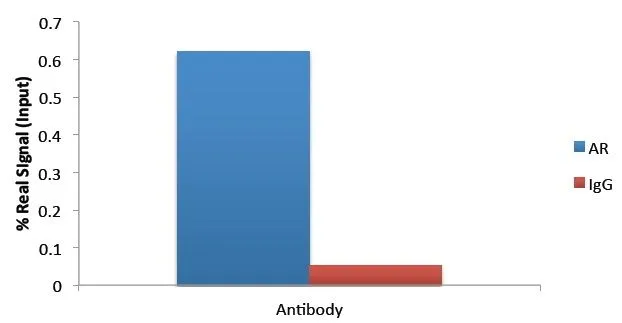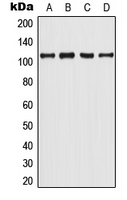![WB analysis of (1) BSA, (2) recombinant protein AR and (3) protein marker using Androgen Receptor antibody [3C6-F12-F11] at a concentration of 0.5 microg/ml. WB analysis of (1) BSA, (2) recombinant protein AR and (3) protein marker using Androgen Receptor antibody [3C6-F12-F11] at a concentration of 0.5 microg/ml.](https://www.genetex.com/upload/website/prouct_img/normal/GTX16032/GTX16032_WB_w_23060620_869.webp)
WB analysis of (1) BSA, (2) recombinant protein AR and (3) protein marker using Androgen Receptor antibody [3C6-F12-F11] at a concentration of 0.5 microg/ml.
Androgen Receptor antibody [3C6-F12-F11]
GTX16032
ApplicationsWestern Blot, ELISA
Product group Antibodies
TargetAR
Overview
- SupplierGeneTex
- Product NameAndrogen Receptor antibody [3C6-F12-F11]
- Delivery Days Customer9
- Application Supplier NoteRecommended Starting Dilutions: For ELISA: Use at a concentration of 12.5 ng/ml. For WB: Use at a dilution of 1:2,000. Optimal working dilutions should be determined experimentally be the end user.
- ApplicationsWestern Blot, ELISA
- CertificationResearch Use Only
- ClonalityMonoclonal
- Clone ID3C6-F12-F11
- Concentration1 mg/ml
- ConjugateUnconjugated
- Gene ID367
- Target nameAR
- Target descriptionandrogen receptor
- Target synonymsAIS, AR8, DHTR, HUMARA, HYSP1, KD, NR3C4, SBMA, SMAX1, TFM, androgen receptor, dihydrotestosterone receptor, nuclear receptor subfamily 3 group C member 4
- HostMouse
- IsotypeIgG1
- Protein IDP10275
- Protein NameAndrogen receptor
- Scientific DescriptionThe androgen receptor gene is more than 90 kb long and codes for a protein that has 3 major functional domains: the N-terminal domain, DNA-binding domain, and androgen-binding domain. The protein functions as a steroid-hormone activated transcription factor. Upon binding the hormone ligand, the receptor dissociates from accessory proteins, translocates into the nucleus, dimerizes, and then stimulates transcription of androgen responsive genes. This gene contains 2 polymorphic trinucleotide repeat segments that encode polyglutamine and polyglycine tracts in the N-terminal transactivation domain of its protein. Expansion of the polyglutamine tract from the normal 9-34 repeats to the pathogenic 38-62 repeats causes spinal bulbar muscular atrophy (SBMA, also known as Kennedys disease). Mutations in this gene are also associated with complete androgen insensitivity (CAIS). Alternative splicing results in multiple transcript variants encoding different isoforms. [provided by RefSeq, Jan 2017]
- Storage Instruction-20°C or -80°C,2°C to 8°C
- UNSPSC12352203




![ICC/IF analysis of LNCaP cells using GTX01536 Androgen Receptor antibody [GT1228]. Blue : DAPI](https://www.genetex.com/upload/website/prouct_img/normal/GTX01536/GTX01536_20200508_ICCIF_w_23053121_194.webp)
![IHC-P analysis of human skin using GTX01898 Androgen Receptor antibody [AR27]. Note the nuclear staining of the epithelial cells.](https://www.genetex.com/upload/website/prouct_img/normal/GTX01898/GTX01898_20200811_IHC-P_100_w_23053121_994.webp)